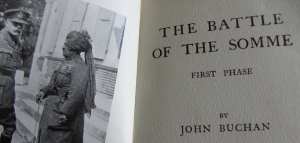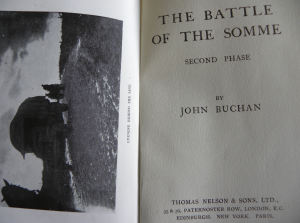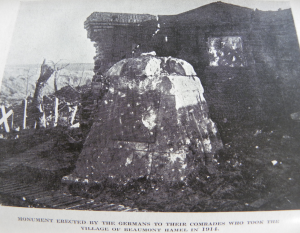IN HIS WORK BUCHAN FAILED TO TELL HIS READERS THAT THERE HAD BEEN OVER 57,000 CASUALTIES ON THE FIRST DAY ALONE

Somme, Picardy, France (GDE 2014)
The end of this week sees the 100th anniversary of the ending of the Battle of Albert (1–13 July 1916) which comprised the first two weeks of Anglo-French offensive operations in the Battle of the Somme.
Also known as the Somme Offensive, the Battle of the Somme was a battle of the First World War between the forces of the British and French Empires on one side and the German Empire on the other.
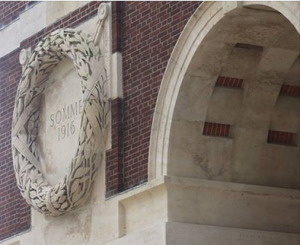
Part of the large Memorial to the Missing of the Somme, at Thiepval, designed by Sir Edwin Lutyens (GDE 2014).
It took place on the upper reaches of the River Somme (Picardy, France) in three major phases and several battles between July and November 1916: at Albert, Bazentin Ridge, Fromelles, Delville Wood, Pozières Ridge, Guillemont, Ginchy, Flers-Courcelette, Morval, Transloy Ridge, Thiepval Ridge, Ancre Heights, and at Ancre. During the battles the use of air power proved important, and the Offensive also saw the first use of the armoured tank as a weapon. By the end of the fighting on the Somme, the British Army had lost over 400,000 men for an advance of a mere six miles. Between all belligerents, over 1,000,000 were killed or wounded.
Although these losses were huge, in his work The Battle of the Somme (1916) John Buchan, author, and later on governor-general of Canada (1935-37) and Chancellor of Edinburgh University (1937-40), described the Somme Offensive as so successful that it marked the end of the trench war and the start of a campaign in the open.
Buchan had been recruited by the War Propaganda Bureau and was asked to organise the publication of a history of the war in the form of a monthly magazine. Unable to persuade others to help him with the project, Buchan decided to tackle it alone, publishing through Thomas Nelson & Sons Ltd. The first instalment appeared in February 1915 in Nelson’s History of the War. Profits and Buchan’s own royalties were donated to war charities.
Later, in the spring 1915, Buchan became attached to the Army as a journalist, and was given responsibility for providing articles for The Times and the Daily News, and he covered the second Battle of Ypres and the Battle of Loos. From June 1916 he was drafting communiqués for Haig and others at General Headquarters Staff (GHQ), and his rank also provided him with the documents needed to write the Nelson’s History of the War.
Buchan’s close relationship with Britain’s military leaders made it extremely difficult for him to include any critical comments about the way the war was being fought, and his History of the War provided the public with a completely false impression of what was happening at the Front. Indeed in 1915 Buchan was telling his readers that Germany was on the edge of defeat.

Sketch map in Buchan’s book showing the changing position of the German front just beyond the town of Albert on the Somme.
A series of pamphlets was written by Buchan and these – works of propaganda – were published by the Oxford University Press. He wrote: Britain’s land war (1915); The achievements of France (1915); and, The Battle of Jutland (1916). Also published in 1916 was his work The Battle of the Somme.

Sketch map of trench systems around Thiepval on the Somme. On the edge of Thiepval Wood today stands the massive brick-built Memorial to the Missing of the Somme designed by Sir Edwin Lutyens and unveiled in 1932.
In his work, The Battle of the Somme, Buchan claimed that the battle of the Somme was an Allied victory and that it would enable Britain to use its superior cavalry. What Buchan did not tell his readers was that of the 110,000 British soldiers making the assault, over 57,000 became casualties, and 20,000 were killed. As said earlier, by the end of the fighting the British Army alone had lost over 400,000 men for an advance of a mere six miles, and between all belligerents, over 1,000,000 were killed or wounded.
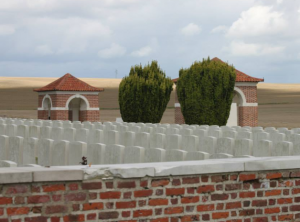
Part of the small CWGC Cemetery at Dernancourt, near Albert, on the Somme, also designed by Sir Edwin Lutyens (GDE 2014).
The map and sketch in this post (from Buchan’s book) show that area of the Somme region of France where the Battle played out. Some of the the most important monuments and some of the largest cemeteries (and many small ones) looked after by the Commonwealth War Graves Commission (CWGC) and of course Volksbund Deutsche Kriegsgräberfürsorge (VDK) are located within the areas shown: Thiepval Memorial; Ulster Memorial Tower; the Lochnagar mine crater at La Boisselle; McRae’s Battalion Great War Memorial at Contalmaison; Courcelette Memorial, a Canadian war memorial (fighting at Flers-Courcelette saw the first use of tanks on the battlefield… on the Somme); and, at cemeteries such as that of Vermandovillers German Military Cemetery and Fricourt German Military Cemetery, and at the small CWGC cemetery at Dernancourt near Albert.
Buchan’s Battle of the Somme, published 1916 by T. Nelson, London, can be requested at Centre for Research Collections, Special Collections, and read in the Reading Room there. It has shelfmark: S.B. .9(40427) Buc.

Dr. Graeme D. Eddie, Assistant Librarian Archives & Manuscripts, Edinburgh University Library

